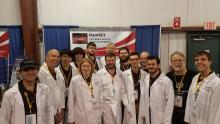Dayton Hamvention HamSCI Photos and Videos
Dayton Hamvention HamSCI Photos and Videos

The HamSCI team completed a successful weekend presenting at the 2017 Dayton Hamvention in Xenia, Ohio. From May 19-21, the HamSCI team ran a booth in the ARRL Expo area where they discussed the HamSCI mission, upcoming experiments, and ways ham radio operators could participate in HamSCI activities. The HamSCI team included members from the New Jersey Institute of Technology, Virginia Tech, the MIT Haystack Observatory, and Citizen Scientists from the general amateur radio community. This includes the upcoming Solar Eclipse QSO Party (SEQP), participation in the EclipseMob Project, and a live demonstration of both Red Pitaya and Rabbit S-9C based Reverse Beacon Network receive nodes. On Saturday morning, HamSCI presented an ARRL-sponsored forum where members gave oral presentations about HamSCI research and activities. Photos, videos of the presentations, and PDFs of presentation slides are included in this post.
HamSCI Forum
Saturday, 9:15 a.m. - 10:30 a.m. – Room 4 (175 cap.)
Moderator: Ward Silver, N0AX
1. “What is HamSCI?”
By Nathaniel Frissell, W2NAF (NJIT-CSTR)
A brief overview of HamSCI’s mission, people, and projects are presented.
2. "Introduction to Space Weather and Radio Propagation”
By Carl Luetzelschwab, K9LA
A broad overview of space weather and the effects on propagation is presented, including a review of general band characteristics, and a discussion of expectations for the bands during the 2017 Total Solar Eclipse.
3. “Upper Level Lows and Six Meter 50 Mhz Sporadic E”
By Joe Dzekevich, K1YOW, presented by Phil Erickson, W1PJE (MIT Haystack Observatory)
Amateur radio is used to explore possible correlations between weather storm systems and sporadic E clouds to see if they are collocated. While some of the main causes of sporadic E propagation are wind shear, meteor strikes and upper atmospheric tides (ultimately coming from solar EUV energy inputs), radio operators have noticed that sporadic E propagation is also changed significantly by hurricanes and storms. Specific cases where K1YOW used amateur radio to investigate the effects of low pressure weather storms on the formation and/or enhancement of 6 meter sporadic E clouds are presented. DX Maps and earth wide weather model charts combined with operations on 6 meters are used to examine possible correlations between the location of the sporadic E clouds and the low pressure weather storm systems. Initial findings show a high degree of correlation when magnetic field strength is taken into consideration.
4. “Ionospheric Impacts of the 2017 Total Solar Eclipse”
By Magda Moses, KM4EGE (Space@Virginia Tech)
On August 21, there will be a total solar eclipse over the United States traveling from Oregon to South Carolina. There are significant differences between the conditions during a solar eclipse and the conditions normally experienced at sunset and sunrise, including the east-west motion of the eclipse terminator, the speed of the transition, and the continued visibility of the corona throughout the eclipse interval. Hence, unique ionospheric effects are produced during over the partial and total phases of the eclipse, reflected by changes in radio propagation. These include variations in the density and altitude of the F2 peak leading to changes in the Maximum Usable Frequency (MUF) and the path length of HF signals among others. Analysis of eclipse RF propagation data with raytracing algorithms will shed light on the underlying processes governing the ionosphere.
5. “VLF/LF and the 2017 Total Solar Eclipse”
By Bill Liles, NQ6Z
Previous solar eclipse studies have observed different propagation effects at VLF/LF frequencies (3-300 kHz) compared with those observed at HF (3-30 MHz) frequencies. These differences are primarily due to the much longer wavelengths at lower frequencies in concert with ionospheric D layer interactions. To better understand the unusual eclipse-induced effects at VLF/LF frequencies, we present EclipseMob, a crowdsourced collection effort that will use smart phones as simple VLF/LF software defined radio (SDR) receivers to record changes in propagation from known transmitters during the 2017 Total Solar Eclipse.
6. “The Solar Eclipse QSO Party: Ionospheric Sounding Using Ham Radio QSOs”
By Nathaniel Frissell, W2NAF (NJIT-CSTR)
The 2017 Total Solar Eclipse is expected to temporarily induce profound changes on ionospheric structure, dynamics, and radio propagation. The ARRL and HamSCI are sponsoring a Solar Eclipse QSO Party (SEQP) that will be used to generate to assist in imaging ionospheric changes before, during, and after the eclipse. Data will be collected through participant submitted logs and the use of automated tools such as the Reverse Beacon Network (RBN), PSKReporter, and WSPRNet. SEQP rules and a prediction of results will be presented.
2017 HamSCI Hamvention Booth Representatives
- Nathaniel Frissell, W2NAF, NJIT
- Josh Katz, KD2JAO, NJIT
- Brendan Keogan, KD2LXD, NJIT
- Josh Vega, KD2NKK, NJIT
- Chris Harrsch, KD2GYD, NJIT
- Nick Zito, KD2MCS, NJIT
- Magda Moses, KM4EGE, Virginia Tech
- Harry Han, KM4ICI, Virginia Tech
- Phil Erickson, W1PJE, MIT Haystack Observatory
- Carl Luetzelschwab, K9LA, ARRL
- Ward Silver, N0AX, ARRL
- Bob Gerzoff, WK2Y, Citizen Scientist
- Bill Liles, NQ6Z, Citizen Scientist
